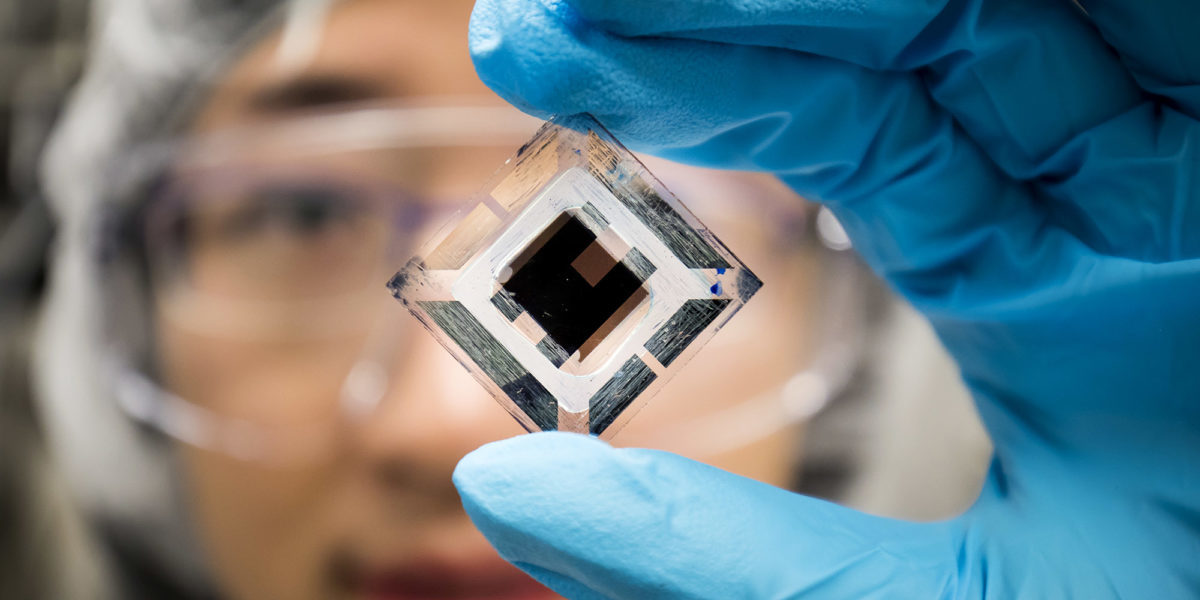The economics, reliability, and efficiency of photovoltaic technologies have exceeded the expectations we held a decade ago. The next phase of development to deliver more powerful and efficient cells will require new kinds of devices. After performing an in-depth review of a process known as “singlet fission,” we believe a singlet fission approach to photovoltaics should not be overlooked. We have undertaken a comprehensive literature review, to be published next week in Chemical Physics Reviews, and would like to share our insights with you.
Let’s first set the scene: Today silicon technologies dominate the photovoltaic market, representing 90% of all deployed PV. There are excellent reasons for this phenomenon: silicon technologies are mature and reliable, benefitting from seven decades of silicon semiconductor research. However, silicon PV does not, and cannot, exploit the full solar spectrum.
Silicon solar cells are thermodynamically limited to converting only 30% of incident sunlight into useful electricity. This is due to two main loss mechanisms: the transmission of photons with energy less than the band gap (1.1eV) and the generation of heat from photons with energy in excess of the band gap. As a result of excellent R&D work, several companies are approaching the 30% limit of current solar cells. As a result, further development of these established technologies will not result in significant boosts in energy conversion efficiency (though cost reductions are still possible, which remains a significant net positive).
The best path forward for step increases in solar cell efficiency is to piggyback on the success of silicon. That is, to develop a ‘something-on-silicon’ tandem device. The question is, what material should that something be? The assumption of the field appears to be to use higher band gap absorbers in a subcell, which can be either electronically (2- or 3-terminal tandem) or mechanically (4-terminal tandem) coupled on top of a silicon cell. Promising materials include organometallic halide perovskites, III-V inorganic semiconductors, and chalcogenides. There are good reasons to develop these technologies, and promising outcomes are being achieved.
However, materials that undergo singlet fission provide a different pathway for enhancing the utilisation of the solar spectrum. Usually, the photovoltaic effect is a one-for-one process. One photon in gives you (at most) one electron out. We call this an “external quantum efficiency”, or EQE, of 100%. When singlet fission is exploited, we can extract two electrons for each photon absorbed – that is we can have EQEs of 200%. Indeed, an EQE in excess of 100% has already been achieved!
Interestingly, this has the advantageous side-effect of reducing operating temperatures, and thereby extending cell lifespans by an estimated 3.7 years. Since singlet fission utilises high energy photons efficiently, less heat is generated than in current technologies, which has a consequent cooling effect on the underlying silicon module. This cooling effect will be present in all something-on-silicon devices but is most significant in singlet fission devices, with an estimated temperature reduction of 2°C (under the IEC61212 standard).
Like tandem cells, the best path forward for singlet fission is to use it as a top layer on a silicon base cell. Unlike other tandem concepts, it is possible to do this with minimal changes to the silicon architecture, reducing both complexity and cost. Moreover, in some singlet fission architectures, we avoid the issue of optimising the conductivity of a new material, by outsourcing all of the electrical transport to the silicon base cell. This removes the need for considering voltage/current matching between the singlet fission and silicon layers.
Finally, the materials used for the singlet fission process are typically small organic molecules or polymers, similar to those already developed in organic light emitting diodes (OLEDs). Therefore, production of singlet fission materials at scale will be able to take advantage of existing chemical synthesis infrastructure.
This means that the efficiency benefits of singlet fission/silicon approach are likely achievable without significantly increasing PV module costs. The two main molecule classes under investigation include polyaromatic hydrocarbons — including light-stable paint pigments — and donor-acceptor polymers which have found utility in existing organic photovoltaic technologies.
There are some drawbacks to singlet fission. As alluded to earlier, the singlet fission approach is in a much earlier stage of development than perovskites, III-V tandems and chalcogenides. So, while proof-of-principle devices have generated much excitement in the field, there is still much work and investment required in both material development and device optimisation.
Considering all the pros and cons, our view is that singlet fission photovoltaics excitingly warrant further research and development.
It is not the aim of this article to disparage any competing technology. Rather, we point out that, as in any financial investment, diversification is key to mitigating risk. This is true for private corporations as well as public research expenditure.
While we are still in the relative infancy of the ‘something-on-silicon’ phase of photovoltaic technology development, we encourage funding agencies and industry to engage with the potential of singlet fission photovoltaics in order to uncover the true potential of these emerging solar technologies.
–
Alexander Baldacchino and Dr Murad Tayebjee are from the School of Photovoltaic and Renewable Energy Engineering at the University of New South Wales (UNSW).
The views and opinions expressed in this article are the author’s own, and do not necessarily reflect those held by pv magazine.
This content is protected by copyright and may not be reused. If you want to cooperate with us and would like to reuse some of our content, please contact: editors@pv-magazine.com.








1 comment
By submitting this form you agree to pv magazine using your data for the purposes of publishing your comment.
Your personal data will only be disclosed or otherwise transmitted to third parties for the purposes of spam filtering or if this is necessary for technical maintenance of the website. Any other transfer to third parties will not take place unless this is justified on the basis of applicable data protection regulations or if pv magazine is legally obliged to do so.
You may revoke this consent at any time with effect for the future, in which case your personal data will be deleted immediately. Otherwise, your data will be deleted if pv magazine has processed your request or the purpose of data storage is fulfilled.
Further information on data privacy can be found in our Data Protection Policy.